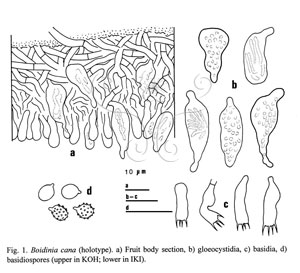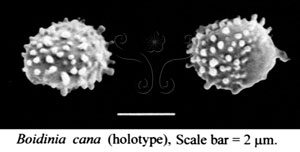|
|
|
|
|
~~ 文獻內容 ~~
Wu, S.H.: Mycotaxon 58: 15-16, 1996
Boidinia cana S.H. Wu, sp. nov. (Figs. 1, 24A-B & 26A)
Basidiocarpum resupinatum, effusum, submembranaceo-pruinosum, 30-60 μm crassum; superficies hymenialis plana. Systema hypharum monomiticum; hyphae efibulatae. Gloeocystidia numerosa, 18-30 × 5-10 μm, SA+. Basidia suburniformae, 12-16 × 3.5-4.5 μm, 4 sterigmatibus. Basidiosporae subglobosae, aculeatae, tenuitunicatae vel exigue crassitunicatae, 3.6-4.1 × 3-3.5 μm, IKI lividae, CB-.
Holotypus: Taiwan. Taoyuan: Shanshia, alt. 280 m, on branch of angiosperm, 9.IX.1988, Wu 880909-41 (N.M.N.S.).
Etymology: From canus {= gray}, referring to the color of the fruit body.
Fruit body resupinate, effuse, adnate, submembranaceous-pruinose, 30-60μm thick in section. Hymenial surface "grey" (2B1), smooth, rarely cracked; margin thinning.
Hyphal system monomitic; hyphae simple-septate. Subiculum fairly uniform, with dense texture; hyphae ± horizontal near substratum, fairly distinct, hyaline or subhyaline, 2-4 μm diam, thin- or slightly thick-walled. Subhymenium not clearly differentiated from subiculum. Gloeocystidia numerous, immersed or emergent, hyaline, usually basally swollen and with narrow apices, rarely clavate, containing yellow and shiny oily contents, 18-30 × 5-10 μm, thin- or slightly thick-walled, SA+. Basidia suburniform, 12-16 × 3.5-4.5 μm, 4-sterigmate. Basidiospores subglobose, with a distinct apiculus, aculeate (smooth in KOH), thin- or slightly thick-walled, 3.6-4.1 × 3-3.5 μm, with fairly homogeneous contents, IKI bluish black, CB-.
Specimen examined: Taiwan (see type).
Distribution: Known only from Taiwan.
Cultural description (FB-mycelium of holotype):
I wk growth: Colony radius 23-26 mm. Advancing zone fimbriate. Mats white. Aerial mycelium almost absent. 2 wk growth: Colony radius 55-65 mm. Advancing zone fimbriate. Mats white. Aerial mycelium sparsely pellicular, with numerous separate whitish granules. 3 wk growth: Plate covered. 6 wk growth: Colony covered. Mats white. Aerial mycelium sparsely pellicular, with numerous separate whitish granules. Hyphal system monomitic; hyphae simple-septate. Aerial hyphae hyaline to yellow, fairly distinct, sparsely or moderately ramified, guttulate, 1-5 μm diam, thin-walled; gloeoplerous hyphae numerous, morphologically indistinguishable from the normal hyphae, thin-walled, SA+. Submerged hyphae similar to aerial hyphae, but lacking the yellow ones and gloeoplerous ones. Cubical crystals present. Odor slightly sweet. Not fruiting.
Oxidase reactions:
Syringaldazine (+), 1-Naphthol (+), L-tyrosine (-), p-Cresol (-).
TAA: +++, 0; 0. GAA: ++++, tr; 15-20. TYA: -, 20; 35.
Species code:
2a, 6, 15a, 32, 36, 38, 43, 50, 54, 64.
Cytology: FB-mycelium dikaryotic.
Remarks: Four characteristics can be used to distinguish Boidinia cana from the closely related B. propinqua. The fruit body of B. propinqua is pale yellow, while that of B. cana is gray. Gloeocystidia of B. propinqua are much longer than those of B. cana, and the shape is cylindrical, not basally swollen and apically narrow as in B. cana. Basidiospores of B. propinqua are slightly smaller (3.3-4 × 2.7-3.2 μm, from holotype), and have a distinct oil-drop which is not present in those of B. cana. Furthermore, B. propinqua was found in Canada and USA (Hjortstam & Ryvarden 1988), while B. cana is known from subtropical Taiwan.
 * 圖說:Drafter:Wu S.H. * 圖說:Drafter:Wu S.H.
* Drafter:Wu S.H.
* 作者:Wu S.H.繪圖,吳聲華繪圖
* 智財權:吳聲華
 * 圖說:Photographer:Wu S.H. * 圖說:Photographer:Wu S.H.
* Photographer:Wu S.H.
* 作者:Wu S.H.拍攝,吳聲華拍攝
* 智財權:吳聲華
 * 圖說:Photographer:Wu S.H. * 圖說:Photographer:Wu S.H.
* Photographer:Wu S.H.
* 作者:Wu S.H.拍攝,吳聲華拍攝
* 智財權:吳聲華
|
|
|
|
|